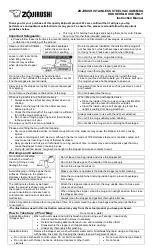
4. Proper steam release and opening
Attention:
Never try to open the pressure cooker with force. The pressure cooker can only be opened if
the internal pressure is completely decreased. This is shown by the red safety valve (4) which
has entirely sunk back into the lid.
Release the steam by using one of the following 3 opportunities.
Before each opening shake the pressure cooker carefully to release steam pockets that may
have formed. Repeat the steam release once again.
As soon as the pressure cooker is not under pressure anymore you can push the release but-
ton (5) and open the cooking pot.
Method 1: Cooling down
Shortly before the end of cooking time, take the pressure cooker from the stove and let it
cool down. When the red safety valve (4) is entirely sunk, push carefully the release button (5)
to let the remaining pressure escape. As soon as no steam escapes anymore, release the but-
ton and shake the pressure cooker cautiously. The pressure can increase once more and the
red safety valve can become visible again. Wait until it has sunk again and push the release
button one more time. Repeat this step until no more steam escapes. By keeping the release
button (5) pressed, you can open the pressure cooker.
Tip: We recommend this method for food with longer cooking time and foaming food.
Boiled potatoes also should be cooled down like this. Other methods easily can let them
burst.
Method 2: Slow pressure reduction with steam control valve
Turn the steam control valve (3) at . The steam now escapes from the
steam control valve. Leave the steam control valve in this position
until the pressure is completely released.
Attention: The escaping steam is very hot!
(figure F)
When the red safety valve is entirely sunk, push carefully the release button (5) to let the
remaining pressure escape. As soon as no steam escapes anymore, release the button and
shake the pressure cooker cautiously. The pressure can increase once more and the red safety
valve can become visible again. Wait until it has sunk again and push the release button one
more time. Repeat this step until no more steam escapes. By keeping the release button (5)
pressed, you can open the pressure cooker.
Method 3: Fast pressure reduction under running water
If the oozing steam of method 2 bothers you, place the pressure cooker in the sink and let
cold water running over the lid (not over the lid handle and the steam control function) until
the red safety valve (4) has sunk completely
(figure G)
.
Now push carefully the release button (5) to let the remaining pressure escape. As soon as
no steam escapes anymore, release the button and shake the pressure cooker cautiously.
The pressure can increase once more and the red safety valve can become visible again.
Cool down the lid once again until the red safety valve has sunk again. Then push the release
button one more time. By keeping the release button (5) pressed, you can open the pressure
cooker.
5. Before first use:
It is imperative to check your cookware before the first use for possible material residues,
especially at the bottom of the cookware. Now and then in production, material particles
such as small metal splinters may appear that remain on the cookware. Please remove them
in order to avoid possible scratches.
Clean your cookware before first use with a soft cloth or sponge, a little water and a mild
washing-up liquid, and cleanse with boiling water 2 - 3 times. Using a paper towel, spread
some cooking oil on the coating (you do not have to use fat or oil the next time it is used).
When cooking on a glass ceramic hob, ensure that there are no particles of dirt between the
bottom of the pot and the hob, since these could scratch the hob surface. Do not slide your
cookware on the hob and always lift it to move it. We can assume no liability for damage that
occurs for the reasons mentioned.
In order to ensure good heat transfer, always place the cookware centrally on the hotplate. If
possible, use the heat stored in your cookware and reduce the energy input.
6. During cooking or roasting:
Use only kitchen gadgets and cooking utensils made of plastic, wood or silicone to stir or
remove the cooked or fried food. Never use metal utensils or sharp or pointed objects. This
preserves the quality of the non-stick coating for as long as possible. Also note that at increa-
sed temperatures, coated surfaces are softer and therefore more susceptible to damage.
Do not use any electrical appliances such as mixers or blenders in your cookware, otherwise
the non-stick coating will be damaged.
Avoid overheating, e. g. by boiling dry, through the use of unsuitable oil or fat, and always be
aware that stove and ceramic hobs can reach temperatures of up to 300 °C and more when
operating at full capacity. Should fat overheat and ignite, never use water to extinguish the
flames, use a blanket or a metal lid.
When cooking with induction cookers, the liquid contained in the food evaporates extremely
fast due to the speed at which it heats up. Prevent your pots from boiling dry by always su-
pervising the cooking process. When used on induction hotplates, unusual humming sounds
can occur due to the electromagnetic properties of the induction stove.
7. After use:
Let your cookware cool before attempting to clean it. Never pour cold water in your hot cook-
ware, as the coating may otherwise develop hairline cracks.
Do not shock the hot glass lid with cold water, but allow it to cool beforehand.
17
16
Summary of Contents for 803100
Page 1: ......





































